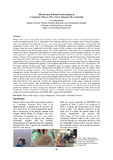| dc.contributor.author | Chanthana, Yos | |
| dc.contributor.editor | Kawamura, Hajime | |
| dc.contributor.editor | Iwata, Tsuyoshi | |
| dc.contributor.editor | Theparoonrat, Yuttana | |
| dc.contributor.editor | Manajit, Nopporn | |
| dc.contributor.editor | Sulit, Virgilia T. | |
| dc.date.accessioned | 2018-11-17T15:00:00Z | |
| dc.date.available | 2018-11-17T15:00:00Z | |
| dc.date.issued | 2016 | |
| dc.identifier.citation | Chanthana, Y. (2016). Effectiveness of blood cockle refugia in community fisheries prey nub 2, Sihanoukville, Cambodia. In H. Kawamura, T. Iwata, Y. Theparoonrat, N. Manajit, & V. T. Sulit (Eds.), Consolidating the Strategies for Fishery Resources Enhancement in Southeast Asia. Proceedings of the Symposium on Strategy for Fisheries Resources Enhancement in the Southeast Asian Region, Pattaya, Thailand, 27-30 July 2015 (pp. 57-58). Samutprakan, Thailand: Training Department, Southeast Asian Fisheries Development Center. | en |
| dc.identifier.isbn | 9786163581600 | |
| dc.identifier.uri | http://hdl.handle.net/20.500.12067/721 | |
| dc.description.abstract | Blood cockle is one of the major marine products in the community but the resource is encountering the risk of stocks degradation mainly due to destruction of the fisheries habitats from rampant illegal fishing by dredgers and over-exploitation. Considering this as a very critical issue, the Fisheries Administration of Cambodia and Community Fisheries Prey Nub 2 in collaboration with SEAFDEC agreed and established the Blood Cockle Refugia. Since the project supported by SEAFDEC ended in 2009, a research was conducted in 2014 to evaluate the effectiveness of the blood cockle refugia. The specific objectives of the study were to evaluate the current status of the refugia management and improve the blood cockle resources in the Community Fisheries. The study used quantitative approach to collect data including key informant interviews with key stakeholders such as fishers, fisheries officers and commune councils, focus group discussion and field observation. Documents from the Integrated Coastal Resources Management Project: Sihanoukville, were reviewed. The report findings indicated that blood cockle refugia is still working under the guidance of the Provincial Fisheries Administration which modified the management approach. The regulation established on blood cockle size to be harvested was no longer enforced because local fishers complained about its negative impact on their daily catch. Other concerns of the Provincial Fisheries Administration included the relatively big proposed site for refugia which was difficult to manage; members of the Community Fisheries seemed not to be actively participating in the management scheme although the concerned local fisheries officers were working hard to implement the said scheme. Nevertheless, the daily catch of blood cockle was significantly stable indicating the effectiveness of the refugia. In general, the blood cockle refugia in Community Fisheries Prey Nub 2 brought a significant impact not only on blood cockle harvest but also on the habitats that this species rely on such as mangroves and sea grass beds that had been well protected. Anyhow, the management approaches of the refugia should be revised to reflect the socio-economic and environmental conditions of the local people in the area. Few suggested recommendations should be taken into account, such as (1) the restriction on size of blood cockle to be harvested should be modified, (2) the coverage area should be reduced, (3) the current Blood Cockle Team of the Community Fisheries should be restructured, and (4) a scientific research on blood cockle biology should be conducted using the baseline data from ICRM-SHV supported by SEAFDEC. | en |
| dc.language.iso | en | en |
| dc.publisher | Training Department, Southeast Asian Fisheries Development Center | en |
| dc.subject | Cambodia | en |
| dc.subject | Tegillarca granosa | |
| dc.title | Effectiveness of Blood Cockle Refugia in Community Fisheries Prey Nub 2, Sihanoukville, Cambodia | en |
| dc.type | Conference paper | en |
| dc.citation.spage | 57 | |
| dc.citation.epage | 58 | |
| dc.subject.asfa | environmental degradation | en |
| dc.subject.asfa | clam fisheries | en |
| dc.subject.asfa | resource management | en |
| dc.subject.asfa | Refuges | en |
| dc.subject.asfa | resource conservation | en |
| dc.subject.asfa | surveys | en |
| dc.subject.asfa | Man-induced effects | en |
| dc.subject.asfa | habitat loss | en |
| dc.subject.asfa | resource depletion | en |
| dc.subject.asfa | coastal zone management | en |
| dc.subject.asfa | dredges | en |
| dc.subject.asfa | illegal fishing | en |
| dc.subject.asfa | dredging | en |
| dc.subject.asfa | marine molluscs | en |
| dc.citation.conferenceTitle | Consolidating the Strategies for Fishery Resources Enhancement in Southeast Asia. Proceedings of the Symposium on Strategy for Fisheries Resources Enhancement in the Southeast Asian Region, Pattaya, Thailand, 27-30 July 2015 | en |

